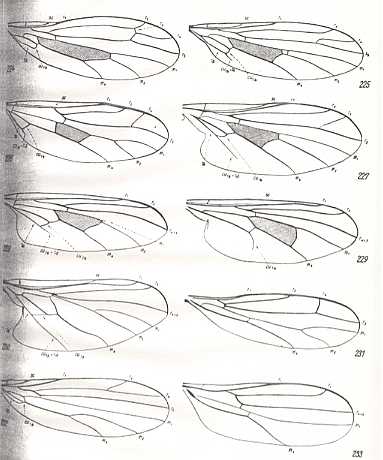

Figure above : Wing-venation of a number of representatives of the family Empididae ( Brachycera-orthorrapha).
Reading from left to right and from top to bottom :
224 -- Dolichocephala irrorata FALL.
225 -- Clinocera inermis Lw.
226 -- Chelifera melanocephala HAL.
227 -- Gloma fuscipennis MEIG.
228 -- Leptopeza flavipes MEIG.
229 -- Hybos culiciformis FABR.
230 -- Bicellaria nigra MEIG.
231 -- Hemerodromia raptoria MEIG.
232 -- Asymphyloptera discrepans COLL.
233 -- Wing, also of a representative of the Empididae. Not labelled by HENNIG as to precisely what representative.
Here we see that further development from the groundplan can lead to forms in which this groundplan is hardly recognizable anymore. Also it is not easy to determine which genus of the family Empididae shows the venational groundplan of the family in its purest form. Those empidid wings with a 3-branched Radial Sector and a discoidal cell point to this groundplan, but Asymphyloptera (232), having no discoidal cell, nevertheless has a 3-branched Radial Sector. And Hemerodromia (231), having no discoidal cell, and having the Cubital and Anal veins totally reduced, nevertheless has its Radial Sector 3-branched.